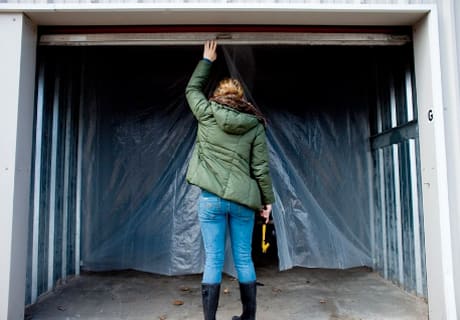Adam Wingard is in the Vanguard. Sorry, had to be done. It's worth rhyming about because his sensational, micro-budgeted "acid horror" flick, Pop Skull, didn't quite make it into the Midnight Madness Programme a few years back. But the buzz from that film eventually earned him a place amongst the convention-busting auteurs of TIFF's more prestigious Vanguard Programme.
Perhaps it's the cast of indie darlings and so-called "king of mumblecore" Joe Swanberg in a lead role or all that handheld camerawork and Lynch-ian drone on the soundtrack that elevate Wingard's film above the negative association of "genre picture." The art house sophistication of the enterprise — exceptional sound, experimental techniques, fine acting, slow pace, washed-out look — and the immense strength of the script by Simon Barret (Dead Birds) make it easy to forget that this is even a serial killer movie.
Amy Seimetz plays Sarah, a recovering alcoholic with a damn good reason for drinking; her boyfriend turned out to be a mass-murderer. Flashbacks show them in happier times and here the true mumblecore charm of the film shines brightest. (For those unfamiliar, this "core" features a group of young filmmakers who favour emotional quagmires over flashy plot devices, naturalism over production value, etc.)
Wingard isn't from the mumbelcore tradition; he's just capitalizing on the talent and newfound cache of its stars. His influences here stem instead from the muted style of Larry Fessenden, who has mentored Wingard since Pop Skull.
The gritty realism plays out at AA meetings as Sarah cautiously rebuilds her life, all while ex-BF/cold-blooded killer Garreth is on the loose, alternating between vicious slaughter and quirky mumbling.
The emotional truth that dominates the film has more in common with All the Real Girls (once the benchmark for hipster minimalism) than straight-to-video fare like Dahmer or Gacy. This draws the viewer in and makes the few gory killings really stand out. Also, it's rare for a horror movie not to have a twist ending these days; it's even rarer for the foundation to have been so well constructed that your jaw actually drops when the revelation is unveiled.
At times, Wingard gets a little carried away with the hand-held camerawork and the out-of-focus shots, but rather than looking amateurish, this ambition suggests we're looking at a future master finding his way. Interestingly, he vowed that this would be his last hand-held film and that he would use a tripod for every shot going forward.
(Snowfort)Perhaps it's the cast of indie darlings and so-called "king of mumblecore" Joe Swanberg in a lead role or all that handheld camerawork and Lynch-ian drone on the soundtrack that elevate Wingard's film above the negative association of "genre picture." The art house sophistication of the enterprise — exceptional sound, experimental techniques, fine acting, slow pace, washed-out look — and the immense strength of the script by Simon Barret (Dead Birds) make it easy to forget that this is even a serial killer movie.
Amy Seimetz plays Sarah, a recovering alcoholic with a damn good reason for drinking; her boyfriend turned out to be a mass-murderer. Flashbacks show them in happier times and here the true mumblecore charm of the film shines brightest. (For those unfamiliar, this "core" features a group of young filmmakers who favour emotional quagmires over flashy plot devices, naturalism over production value, etc.)
Wingard isn't from the mumbelcore tradition; he's just capitalizing on the talent and newfound cache of its stars. His influences here stem instead from the muted style of Larry Fessenden, who has mentored Wingard since Pop Skull.
The gritty realism plays out at AA meetings as Sarah cautiously rebuilds her life, all while ex-BF/cold-blooded killer Garreth is on the loose, alternating between vicious slaughter and quirky mumbling.
The emotional truth that dominates the film has more in common with All the Real Girls (once the benchmark for hipster minimalism) than straight-to-video fare like Dahmer or Gacy. This draws the viewer in and makes the few gory killings really stand out. Also, it's rare for a horror movie not to have a twist ending these days; it's even rarer for the foundation to have been so well constructed that your jaw actually drops when the revelation is unveiled.
At times, Wingard gets a little carried away with the hand-held camerawork and the out-of-focus shots, but rather than looking amateurish, this ambition suggests we're looking at a future master finding his way. Interestingly, he vowed that this would be his last hand-held film and that he would use a tripod for every shot going forward.
